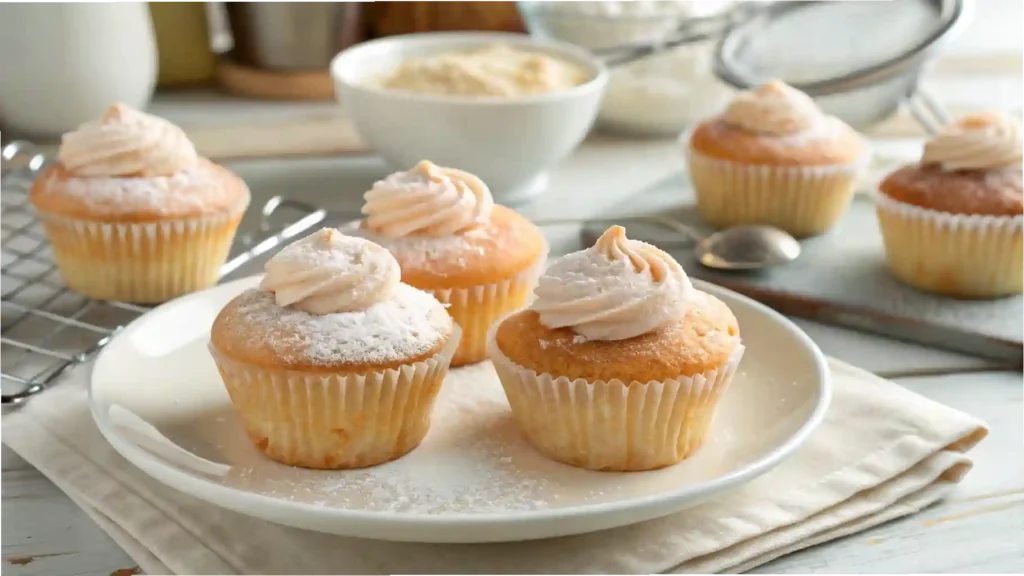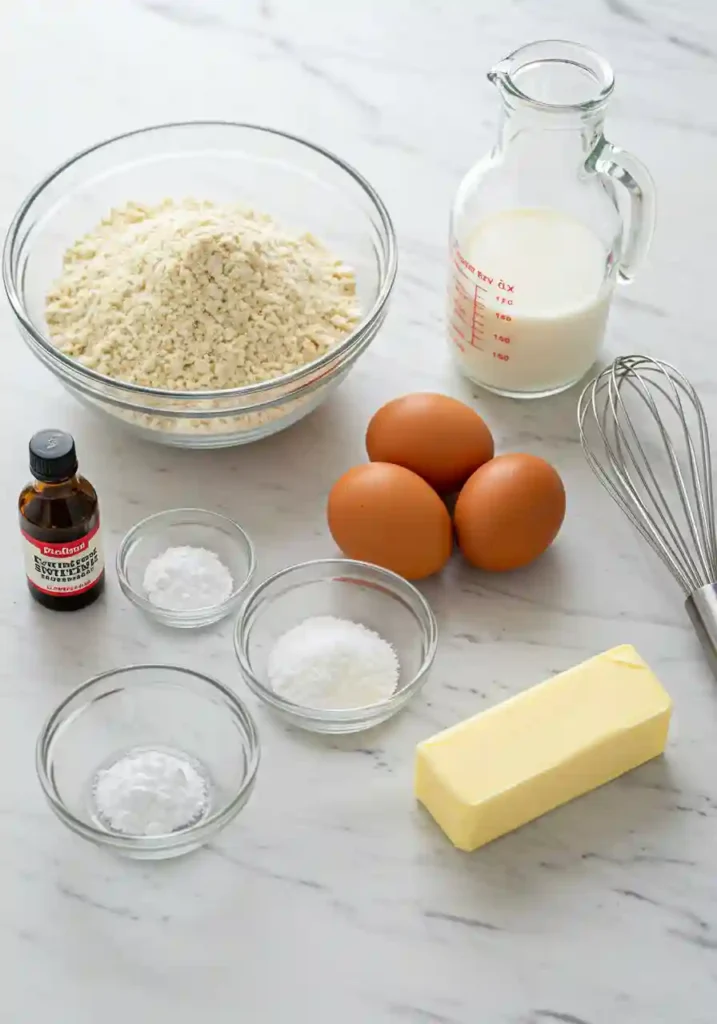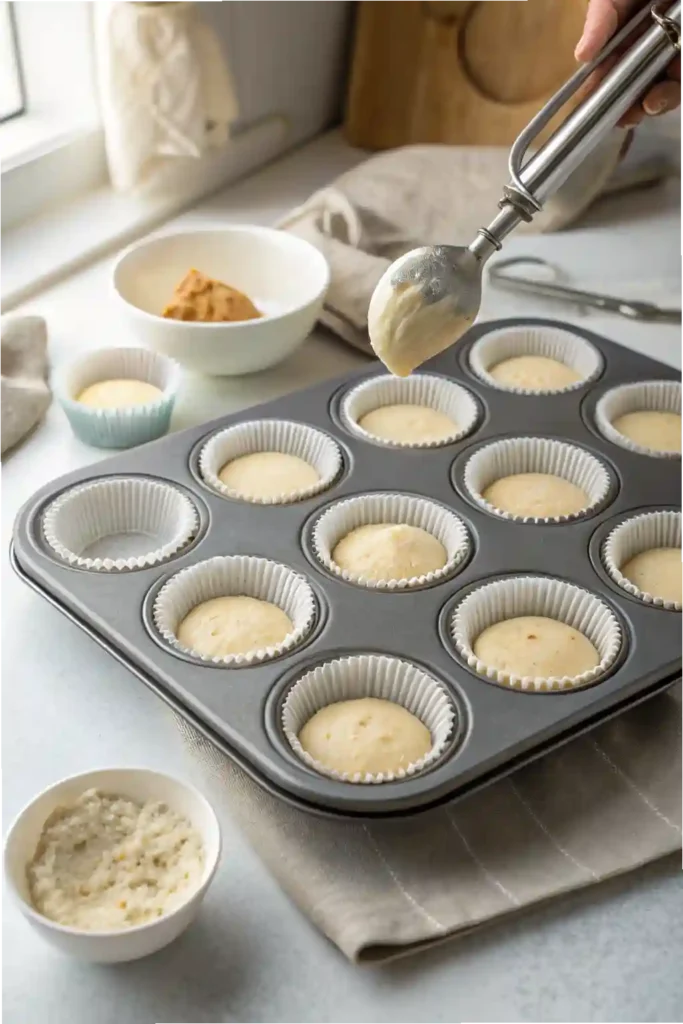Traditional cupcakes use granulated sugar for sweetness and structure. But with rising interest in low-carb and low-sugar lifestyles, many home cooks are seeking ways to create cupcakes without sugar. You can achieve a tender crumb by substituting sugar with alternatives such as erythritol, stevia, or monk fruit sweeteners. These sweeteners often measure like sugar, simplifying the baking process, and some even contain fewer calories or have minimal impact on blood glucose levels.

Sugar free cupcakes are especially great for those with diabetes, people on a keto or low-carb diet, or anyone watching their sugar intake. Modern sugar substitutes have improved significantly in flavor, reducing that old metallic or bitter aftertaste. When combined with a little fat (like butter or oil), eggs, and quality flavorings, these cupcakes can taste surprisingly close to traditional ones.
Table of Contents
Key Benefits
- Reduced Sugar Impact
Baking without standard sugar helps you avoid sudden spikes in blood sugar. That’s beneficial for people managing diabetes or watching their carbohydrate intake. - Fewer Calories
Many sugar alternatives offer sweetness with fewer calories. Some, like erythritol, have almost zero net carbs. For those on keto or low-carb diets, this allows you to enjoy a cupcake without derailing your meal plan. - Suitable for Various Diets
You can make these cupcakes gluten free by swapping regular flour for a gluten-free blend. You can also adjust dairy content for a lactose-free or vegan version. - Tastes Like a Real Treat
Thanks to improvements in sugar alternatives, you can get an enjoyable sweet taste minus the typical sugar guilt. If you use monk fruit or stevia blends formulated for baking, the flavor can be quite close to real sugar. - Kid-Friendly Option
If you want to limit your child’s sugar intake or if they need to avoid sugar for health reasons, these cupcakes let them still have a birthday treat or a classroom snack. - Bake with Familiar Techniques
The process is similar to any cupcake recipe: mix wet ingredients, combine dry ingredients, fold them together, and bake. Minimal extra steps needed. - A Gateway to More Sugar Free Desserts
Once you master sugar free cupcakes, you can extend those techniques to cookies, brownies, or muffins. The more you practice with sugar alternatives, the more comfortable you’ll get.
Ingredients
Below are the essential elements to create a dozen sugar free cupcakes. Keep in mind that you can modify certain aspects to fit personal dietary needs:

- Flour (1½ cups)
- All-purpose flour works for standard cupcakes. For gluten free, use a 1:1 gluten-free flour blend.
- All-purpose flour works for standard cupcakes. For gluten free, use a 1:1 gluten-free flour blend.
- Sugar Alternative (¾ cup)
- Choose a sweetener that measures like sugar and is suitable for baking (erythritol, stevia-based blends, or monk fruit sweeteners). Each brand may differ in sweetness.
- Choose a sweetener that measures like sugar and is suitable for baking (erythritol, stevia-based blends, or monk fruit sweeteners). Each brand may differ in sweetness.
- Baking Powder (1½ teaspoons)
- Helps the cupcakes rise, ensuring they turn out fluffy.
- Helps the cupcakes rise, ensuring they turn out fluffy.
- Salt (¼ teaspoon)
- Enhances flavor. If you use salted butter later, reduce this amount.
- Enhances flavor. If you use salted butter later, reduce this amount.
- Butter or Oil (½ cup, softened if butter)
- Provides moisture, richness, and tenderness. Coconut oil or vegetable oil can also be used for a dairy-free approach.
- Provides moisture, richness, and tenderness. Coconut oil or vegetable oil can also be used for a dairy-free approach.
- Eggs (2 large, room temperature)
- Binds the batter and traps air for a light crumb. If vegan, you might try flax eggs or other egg substitutes.
- Binds the batter and traps air for a light crumb. If vegan, you might try flax eggs or other egg substitutes.
- Vanilla Extract (1½ teaspoons)
- Adds aromatic depth, offsetting any possible aftertaste from sweeteners.
- Adds aromatic depth, offsetting any possible aftertaste from sweeteners.
- Milk (½ cup)
- Use dairy or non-dairy (almond, soy, or coconut) to moisten the batter.
- Use dairy or non-dairy (almond, soy, or coconut) to moisten the batter.
- Optional Flavor Additions
- Lemon Zest (1 tablespoon) for a citrus note.
- Cocoa Powder (2 tablespoons) if you want chocolate cupcakes (you might slightly adjust the flour down or the liquid up).
- Cinnamon (½ teaspoon) for a warm, spiced edge.
- Lemon Zest (1 tablespoon) for a citrus note.
Instructions
Below is a straightforward method to ensure you get moist, fluffy, and sugar free cupcakes:
Step 1: Prep Your Tools
- Preheat your oven to 350°F (175°C).
- Line a 12-cup cupcake pan with cupcake liners. Alternatively, lightly grease the wells if you’re out of liners.
Step 2: Combine Dry Ingredients
- Whisk Flour and Leaveners: In a medium bowl, whisk 1½ cups flour, 1½ teaspoons baking powder, and ¼ teaspoon salt. If adding cocoa powder, mix it in here.
- Set Aside for later.
Step 3: Cream the Butter (or Oil) with Sweetener
- Butter or Oil: In a large mixing bowl, place ½ cup butter (softened) or oil.
- Sugar Alternative: Add ¾ cup of your chosen sweetener.
- Mix: Using an electric mixer or stand mixer, cream them together on medium speed for about 2–3 minutes until the blend looks fluffy and slightly lighter in color. This step whips air into the fat, vital for a soft crumb.
Step 4: Add Eggs and Vanilla
- Eggs: Crack 2 large eggs in, one at a time, beating well after each addition.
- Vanilla Extract: Stir in 1½ teaspoons. If you have other extracts (like almond or lemon), you could add a few drops for variety.
Step 5: Alternate Dry and Wet

- Dry-Wet Mixture: With your mixer on low speed, alternate adding the flour mixture and ½ cup milk. Start with one-third of the flour mix, then half the milk, and repeat.
- Mix Lightly: Avoid overmixing. Once the batter forms, stop and scrape down the sides. Overmixing can lead to dense cupcakes.
Step 6: Fill and Bake

- Fill Liners: Spoon or ladle the batter into cupcake liners, each about two-thirds full.
- Bake: Place in the preheated oven for about 18–22 minutes. Check doneness by inserting a toothpick into the center of a cupcake. If it comes out clean or with a few moist crumbs, they’re done.
- Cool: Let cupcakes rest in the pan for 5 minutes, then move them to a wire rack to cool completely.
Step 7: Optional Frosting
- Sugar Free Frosting: If you want to frost them, mix softened butter or cream cheese with a sugar alternative (like powdered erythritol) and a bit of vanilla or unsweetened cocoa. Spread or pipe onto fully cooled cupcakes.
- Decorate: Add a sprinkle of unsweetened coconut, sugar free chocolate shavings, or a dusting of cinnamon on top.
Pro Tips and Variations
- Room Temperature Ingredients
Make sure butter, eggs, and milk aren’t cold. This helps them blend seamlessly, producing a smoother batter. - Avoid Overbeating
Especially after adding flour, keep mixing to a minimum. Overworking the batter can lead to dense, rubbery cupcakes. - Check Sweetness Level
Different sweeteners vary in potency. Taste your batter for sweetness (though it contains raw egg) or do a small test bake with a single mini liner if you’re cautious about raw batter. - Enhance Moisture
If your brand of sweetener leaves a dryness, add a tablespoon of sour cream or Greek yogurt. This can help maintain a moist crumb. - Turn Them into Chocolate Cupcakes
Add 2–3 tablespoons of unsweetened cocoa powder to the dry ingredients. You might reduce flour by the same measure to keep the overall dryness balanced. If that’s still not chocolatey enough, swirl in melted, sugar-free chocolate. - Try Keto or Low Carb
Replace wheat flour with almond flour or a keto-friendly flour blend. You’ll need to adjust ratios slightly, and the texture may be a tad denser, but it can work with a bit of experimentation. - Experiment with Frosting
For a tangy note, use sugar-free lemon or strawberry frosting. Or if you want a “cream cheese” swirl, swirl some softened cream cheese sweetened with stevia into the top of each unbaked cupcake. - Storage
Keep them in a sealed container at room temperature for 2–3 days or in the fridge for up to a week. Unfrosted cupcakes also freeze well for up to 3 months.
Serving Suggestions
- Simple Tea-Time Snack
Enjoy a sugar free cupcake with a warm cup of tea or coffee. The gentle sweetness pairs nicely with a robust beverage. - Kid-Friendly Dessert
If you’re serving children who can’t have sugar or who you prefer to keep on a lower-sugar diet, these cupcakes serve as a wonderful treat. Add some rainbow sprinkles or sugar-free whipped cream on top. - Party Platters
Make mini cupcakes for potlucks, birthdays, or holiday gatherings. People might not even notice they’re sugar free because they’re so tasty. - Decorate Festively
Add a swirl of sugar-free buttercream and top with unsweetened shredded coconut or edible glitter for birthdays or baby showers. This proves you can keep celebrations sweet without refined sugar. - Pair with Fresh Fruit
Serve the cupcakes with a side of berries or a sugar-free fruit compote. The fruity tang complements the mild sweetness of the cupcakes.
Conclusion
Baking sugar free cupcakes doesn’t mean compromising taste or texture. With the correct sugar alternative—be it erythritol, monk fruit, or stevia—you can achieve fluffy, soft cupcakes that rival traditional ones. The key is to follow standard cupcake baking principles: cream the butter and sweetener properly, don’t overmix your batter, and watch your oven time. By controlling sugar, you open the door to a variety of dietary needs—helping diabetics, low-carb enthusiasts, or simply health-conscious individuals enjoy a sweet treat.
Test out this recipe the next time you want to indulge your sweet tooth guilt-free. Feel free to add different flavors, try various frostings, or make a chocolate version. Once you see how well sugar-free baking can work, you might never go back to full-sugar cupcakes again. Explore your creativity and, most importantly, savor each bite without worrying about high sugar spikes.

Sugar Free Cupcakes
Ingredients
Flour (1½ cups)
- All-purpose flour works for standard cupcakes. For gluten free use a 1:1 gluten-free flour blend.
Sugar Alternative (¾ cup)
- Choose a sweetener that measures like sugar and is suitable for baking erythritol, stevia-based blends, or monk fruit sweeteners. Each brand may differ in sweetness.
Baking Powder (1½ teaspoons)
- Helps the cupcakes rise ensuring they turn out fluffy.
Salt (¼ teaspoon)
- Enhances flavor. If you use salted butter later reduce this amount.
Butter or Oil (½ cup, softened if butter)
- Provides moisture richness, and tenderness. Coconut oil or vegetable oil can also be used for a dairy-free approach.
Eggs (2 large, room temperature)
- Binds the batter and traps air for a light crumb. If vegan you might try flax eggs or other egg substitutes.
Vanilla Extract (1½ teaspoons)
- Adds aromatic depth offsetting any possible aftertaste from sweeteners.
Milk (½ cup)
- Use dairy or non-dairy almond, soy, or coconut to moisten the batter.
Optional Flavor Additions
- Lemon Zest 1 tablespoon for a citrus note.
- Cocoa Powder 2 tablespoons if you want chocolate cupcakes (you might slightly adjust the flour down or the liquid up).
- Cinnamon ½ teaspoon for a warm, spiced edge.
Instructions
Step 1: Prep Your Tools
- Preheat your oven to 350°F (175°C).
- Line a 12-cup cupcake pan with cupcake liners. Alternatively, lightly grease the wells if you’re out of liners.
Step 2: Combine Dry Ingredients
- Whisk Flour and Leaveners: In a medium bowl, whisk 1½ cups flour, 1½ teaspoons baking powder, and ¼ teaspoon salt. If adding cocoa powder, mix it in here.
- Set Aside for later.
Step 3: Cream the Butter (or Oil) with Sweetener
- Butter or Oil: In a large mixing bowl, place ½ cup butter (softened) or oil.
- Sugar Alternative: Add ¾ cup of your chosen sweetener.
- Mix: Using an electric mixer or stand mixer, cream them together on medium speed for about 2–3 minutes until the blend looks fluffy and slightly lighter in color. This step whips air into the fat, vital for a soft crumb.
Step 4: Add Eggs and Vanilla
- Eggs: Crack 2 large eggs in, one at a time, beating well after each addition.
- Vanilla Extract: Stir in 1½ teaspoons. If you have other extracts (like almond or lemon), you could add a few drops for variety.
Step 5: Alternate Dry and Wet
- Dry-Wet Mixture: With your mixer on low speed, alternate adding the flour mixture and ½ cup milk. Start with one-third of the flour mix, then half the milk, and repeat.
- Mix Lightly: Avoid overmixing. Once the batter forms, stop and scrape down the sides. Overmixing can lead to dense cupcakes.
Step 6: Fill and Bake
- Fill Liners: Spoon or ladle the batter into cupcake liners, each about two-thirds full.
- Bake: Place in the preheated oven for about 18–22 minutes. Check doneness by inserting a toothpick into the center of a cupcake. If it comes out clean or with a few moist crumbs, they’re done.
- Cool: Let cupcakes rest in the pan for 5 minutes, then move them to a wire rack to cool completely.
Step 7: Optional Frosting
- Sugar Free Frosting: If you want to frost them, mix softened butter or cream cheese with a sugar alternative (like powdered erythritol) and a bit of vanilla or unsweetened cocoa. Spread or pipe onto fully cooled cupcakes.
- Decorate: Add a sprinkle of unsweetened coconut, sugar free chocolate shavings, or a dusting of cinnamon on top.
Notes
Nutrition Information (Per Serving)
Calories: 130 kcal Fat: 9g Protein: 4g Carbs: 9g Fiber: 1g Sugar: 0.5gFAQs
Below are answers to common questions about sugar-free baking, cupcake substitutions, and sweeteners:
Can cupcakes be made without sugar?
Yes. You can replace sugar with a sugar substitute like erythritol, stevia-based blends, or monk fruit sweeteners to achieve sweetness without regular sugar.
Can diabetics eat sugar-free cupcakes?
Diabetics can often enjoy sugar-free cupcakes in moderation because they have less impact on blood sugar. Still, check carb counts and consult with a healthcare professional to be sure.
What is a good sugar alternative for cupcakes?
Erythritol, stevia blends, and monk fruit sweeteners are popular. They measure similarly to sugar and maintain a flavor close to standard sugar.
What happens if you don’t put sugar in cupcakes?
Cupcakes without any sweetener might taste bland and can also affect texture. Sugar helps keep baked goods moist and flavorful, so you typically need a substitute to maintain both taste and structure.
Can I replace sugar with honey in cupcakes?
Yes, honey adds moisture and sweetness. However, honey has a distinct flavor and extra moisture, so reduce liquids slightly and watch the bake time. Also, honey is not sugar free, so it’s not suitable for a truly sugar-free recipe, but it’s a natural sweetener if you’re just avoiding refined sugar.
What is a natural sugar substitute for baking?
Options include stevia, monk fruit, and sometimes coconut sugar (though coconut sugar still contains fructose). Choose a brand formulated for baking to ensure the right sweetness level and texture.


